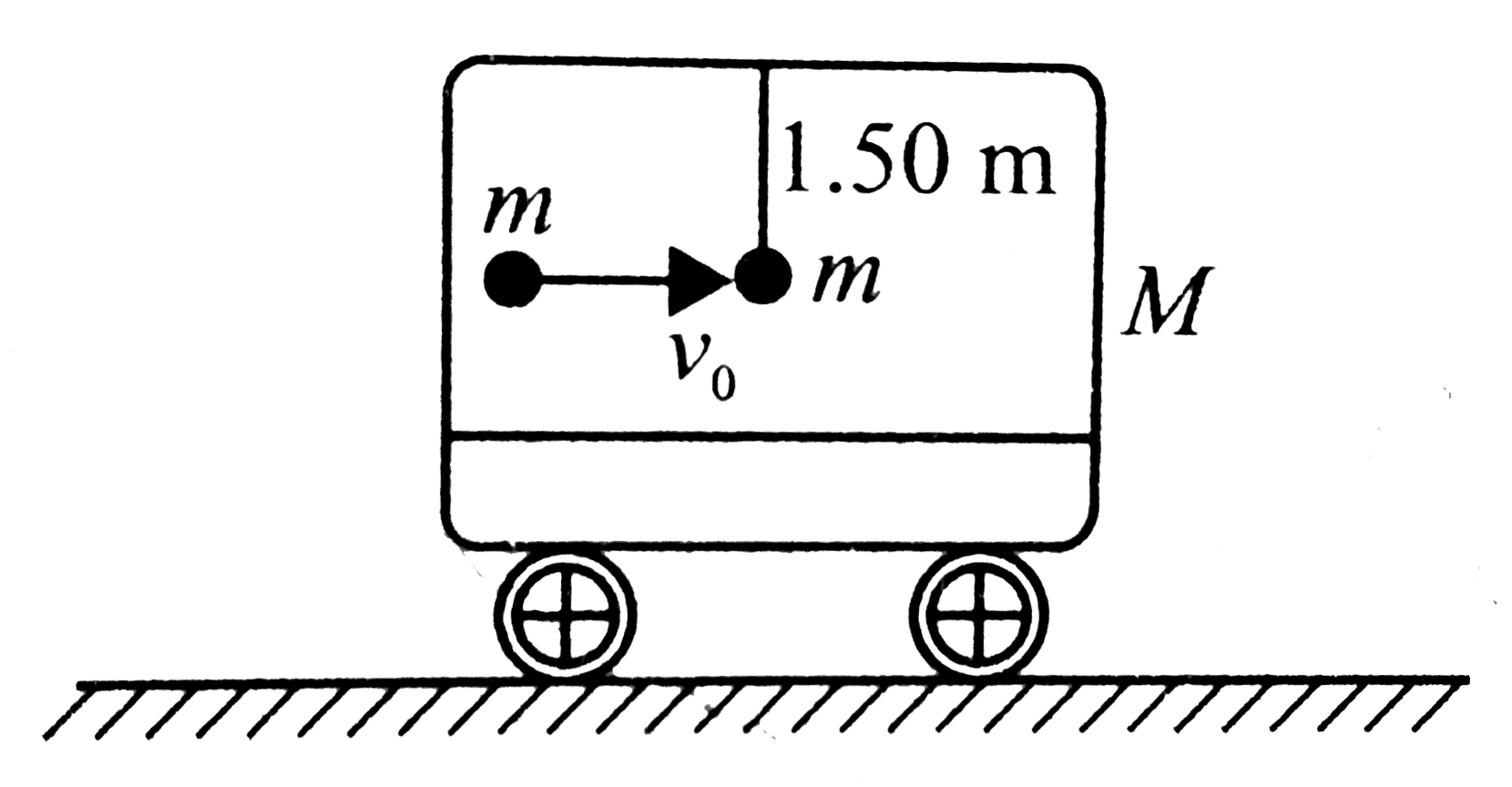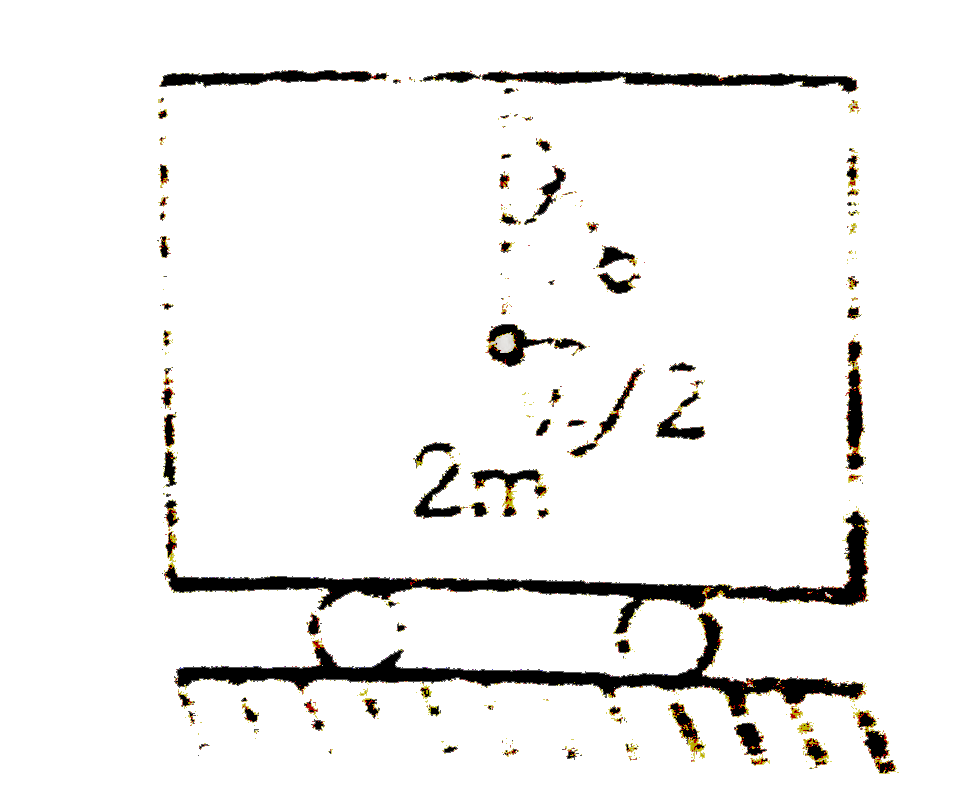A ball of mass in m=1kg is hung vertically by a thread of length l=1.50m. Upper end of the thread is attached to the ceiling of a trolley of mass M=4kg. Initially, the trolley is stationary and it is free to move along horizontal rails without friction. A shell of mass m=1kg, moving horizontally with velocity v0=6m/s collides with the ball and gets stuck with it. As a result, the thread starts to deflect towards right.

At the time of maximum deflection of the thread with vertical, the trolley will move with velocitySolution in Gujrati
The correct Answer is:37∘
COLM:mv0=(M+2m)v1
v1=mv0m=v06=1m/s
COME:⇒12(2m)(v02)2=12Mv21+2m×g×h+12(2m)v21
⇒h=0.3m=L(1−cosθ)
cosθ=1−315=45⇒0=37∘

Topper's Solved these Questions
- CENTRE OF MASSBOOK - ALLEN CHAPTER - CENTRE OF MASSEXERCISE - EXERCISE-V A
20 Videos
- CENTRE OF MASSBOOK - ALLEN CHAPTER - CENTRE OF MASSEXERCISE - EXERCISE-V B
19 Videos
- CENTRE OF MASSBOOK - ALLEN CHAPTER - CENTRE OF MASSEXERCISE - EXERCISE-IV A
32 Videos
- BASIC MATHEMATICS USED IN PHYSICS &VECTORS BOOK - ALLEN CHAPTER - BASIC MATHEMATICS USED IN PHYSICS &VECTORS EXERCISE - EXERCISE-IV ASSERTION & REASON
11 Videos
- ELASTICITY, SURFACE TENSION AND FLUID MECHANICSBOOK - ALLEN CHAPTER - ELASTICITY, SURFACE TENSION AND FLUID MECHANICSEXERCISE - Exercise 5 B (Integer Type Questions)
3 Videos
Similar Questions
Two identical particles move towards each other with velocity 2v and v respectively. The velocity of centre of mass is
View SolutionTwo particles of masses m1 and m2 in projectile motion have velocities →v1 and →v2 , respectively , at time t=0. They collide at time t0. Their velocities become →v'1 and →v'2 at time 2t0 while still moving in air. The value of ∣∣∣(m1→v'1+m2→v'2)−(m1→v1+m2→v2)∣∣∣
View SolutionFig. shown a uniform square plate from identical squares at the corners can be removed. (a) Where is the centre of mass of the plate originally ? (b) Where is it after square 1 is removed ?
(c ) where is it after squares 1 and 2 are removed ? (d) Where is c.m after squares 1,2,3, are removed ?
(f) Where is c.m after all the four squares are removed ? Answer in terms of quadrants and axes.

View SolutionAssertion: If the initial and final positions coincide, the displacement is a null vector.
Reason: A physical quantity can not be called a vector, if its magnitude is zero.
View SolutionTwo soap bubbles A and B are kept in a closed chamber where the air is maintained at pressure 8N/m2.The radii of bubbles A and B are 2cm and 4cm, respectively. Surface tension of the soap-water used to make bubbles is 0.04N/m. Find tha ratio nB/nA, where nA and nB are the number of moles of air in bubbles A and B, respectively. [Neglect the effect of gravity.]
View SolutionA shell of mass 1kg is projected with velocity 20m//s at an angle 60^@ with horizontal. It collides inelastically with a ball of mass 1kg which is suspended through a thread of length 1m . The other end of the thread is attached to the ceiling of a trolley of mass 4/3kg as shown in figure. Initially the trolley is stationary and it is free to move along horizontal rails wihtout any friction. What is the maximum deflection of the thread with vertical? String does not slack. Take g=10m//s^2 .
View SolutionIn the arrangements shown in the figure masses of each ball is 1 kg and mass of trolley is 4 kg . In the figure, shell of mass 1 kg moving horizontally with velocity v = 6 ms^(-1) collides with the ball and get stuck to it then its maximum deflection of the thread (length 1.5 m ) with vertical
View SolutionA ball of mass in m= 1 kg is hung vertically by a thread of length l = 1.50 m . Upper end of the thread is attached to the ceiling of a trolley of mass M= 4 kg . Initially, the trolley is stationary and it is free to move along horizontal rails without friction. A shell of mass m=1 kg, moving horizontally with velocity v_(0) = 6 m//s collides with the ball and gets stuck with it. As a result, the thread starts to deflect towards right. The velocity of the combined body just after collision is
View SolutionA ball of mass in m= 1 kg is hung vertically by a thread of length l = 1.50 m . Upper end of the thread is attached to the ceiling of a trolley of mass M= 4 kg . Initially, the trolley is stationary and it is free to move along horizontal rails without friction. A shell of mass m=1 kg , moving horizontally with velocity v_(0 )= 6 m//s collides with the ball and gets stuck with it. As a result, the thread starts to deflect towards right. At the time of maximum deflection of the thread with vertical, the trolley will move with velocity
View SolutionA ball of mass in m= 1 kg is hung vertically by a thread of length l = 1.50 m . Upper end of the thread is attached to the ceiling of a trolley of mass M= 4 kg . Initially, the trolley is stationary and it is free to move along horizontal rails without friction. A shell of mass m=1 kg , moving horizontally with velocity v_(0) = 6 m//s collides with the ball and gets stuck with it. As a result, the thread starts to deflect towards right. The maximum deflection of the thread with the vertical is
View SolutionA ball of mass m = 1 kg is hung vertically by a thread of length 1=1.50 m . Upper end of the thread is attached to the ceiling of a trolley of mass M = 4kg . Initially, the trolley is stationary and it is free to move along horizontal rails with out friction. A shell of mass m=1 kg , moving horizontally with velocity v_(0) = 6m//s collides with thread starts to deflect towards right The velocity of the combined body just after collision is
View SolutionA ball of mass m=1kg is hung vertically by a thread of length 1=1.50m. Upper end of the thread is attached to the ceiling of a trolley of mass M=4kg. Initially, the trolley is stationary and it is free to move along horizontal rails with out friction. A shell of mass m=1kg, moving horizontally with velocity v0=6m/s collides with thread starts to deflect towards right

At the time a maximum deflection of the thread with vertical, the trolley will move with velocity
View SolutionA ball of mass m = 1 kg is hung vertically by a thread of length 1=1.50 m . Upper end of the thread is attached to the ceiling of a trolley of mass M = 4kg . Initially, the trolley is stationary and it is free to move along horizontal rails with out friction. A shell of mass m=1 kg , moving horizontally with velocity v_(0) = 6m//s collides with thread starts to deflect towards right The maximum deflection of the thread with the vertical is
View SolutionA monkey of mass 20 kg rides on a 40 kg trolley moving at a constant speed of 8 m/s along a horizontal track. Frictional force can be neglected. If the monkey jumps vertically, with respect to the moving trolley, the catch the overhanging branch of tree, the speed of the trolley after the monkey has jumped off is :-
View SolutionIn the figure shown, the mass of the trolley is 100 kg and it can move without friction on the horizontal floor. It length is 12 cm. The mass of the girl is 50 kg. Friction exists between is 12 m. The mass of the girl is 50 kg. Friction exists between the shoes of the girl and the trolley's upper surface, with μ=1/3, The girl can run with a maximum speed =9m/s on the surface of the trolley, with respect to the surface =9m/s on the surface of thr trolley, with respect to the surface. At t=0 the girlm starts running from left to the right. The trolley was initially stationary. (g=10m/s2)

The displacement of the trolley by the time the girl reaches the right end of the trolley is :
View SolutionThe figure shows a man of mass m standing at the end A of a trolley of maas M placed at rest on a smooth horizontal surface. The man starts moving towards the end B with a velocity u_(rel) with respect to the trolley. The length of the trolley is L. When the man starts moving, then the velocity of the trolley v_(2) with respect to ground will be:
View Solution
